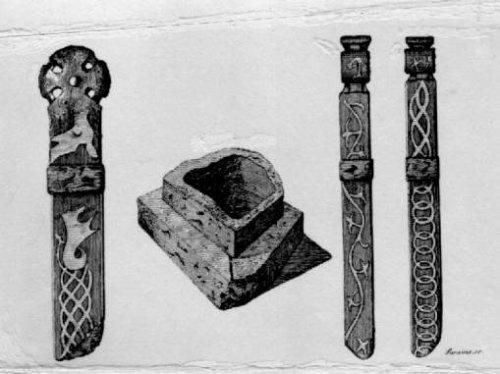The Viking Cross
This is the only pre-Conquest cross in Leicestershire that stands complete. This is firstly due to the fact that it is carved from a single piece of stone, rather than having the head formed of a separate piece mortised into the shaft, and secondly because, when it was taken down, probably at the time of the Reformation (Edward VI’s Privy Council having issued an Order in 1547 to destroy or deface all religious imagery that might be considered idolatrous), it was not broken up, as was the fate of so many ancient crosses, but was instead put to use as a footbridge across a muddy ditch on the way to Saltby. This explains why the east facing side of the cross is completely smooth, and devoid of any detail. When the cross was taken down the socket within which the shaft stood was, however, left in situ in Sproxton churchyard, and it is illustrated in its own right in John Nichols’ ‘History and Antiquities of the County of Leicester’ (1794). Illustrations of the cross which accompany Nichols’ text are reproduced on the right (Click for a larger image) ,In that same year of 1794 the shaft was rescued from profane use by William Mountsey (Vicar of Sproxton 1791-1818), who had it erected as an ornament within the grotto in the garden of his newly built Vicarage. It is assumed that it was John Nichols who was responsible for instigating the cross’s rescue. The shaft was not reunited with its socket until 1884, the two components being secured with a lead join (the restoration of Sproxton Church had been completed the previous year). There is a local tradition, no doubt fanciful, that the socket stone is of extremely ancient age, having originally been connected with pagan rites of animal sacrifice, and that it was christianised by having the cross shaft inserted into it. The cross stands 7' 9" in total height, the lowest 1' 3" being formed by the socket, which is 2' 4" square. The cross-head accounts for 1' 9½" of the height. The broad side of the shaft is 1' 3½" wide at the base, tapering to 1' 1" where it meets the head, and the narrow side of the shaft measures 10". Note how the head of the cross ‘weeps’, that is to say, it leans slightly to one side. T.E. Routh, in his description of the cross contained in Volume XX (1937) of the Transactions of the Leicestershire Archaeological Society, which is the best account of the Sproxton Cross so far written, intimates that the slight lean to the north is ‘…probably due to the carver’s having to make the best of defective material, not being able to get a better stone’. It is worth mentioning in passing that the stone would not have been carved in an upright position, but a horizontal one, laid flat upon the ground. An iron chisel would have been used to carve the detail. The stone is Jurassic period oolitic limestone, probably quarried in the area around Colsterworth, some four or so miles east of Sproxton, just across the county boundary in Lincolnshire.




























